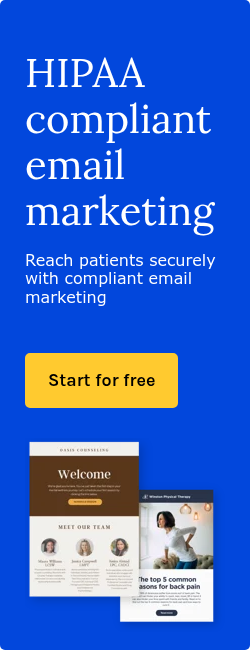
The Journal of Medicine and Life article ‘The adaptation of health care marketing to the digital era’ notes the benefit of segmentation to healthcare marketing practices, “A big advantage is the targeting capability of the electronic media that has led to its being used by managers of marketing in medical institutions as means of advertisement when they develop the marketing strategies.”
Paubox Marketing’s contact management and segmentation features enable healthcare organizations to deliver precise, relevant messages by securely organizing patient data and categorizing audiences based on specific criteria. The platform allows HIPAA compliant storage of protected health information (PHI), including demographics, medical history, and treatment details.
By filtering contacts into subgroups, like patients with chronic conditions or those due for vaccinations, marketers can tailor content to address individual healthcare needs. This approach aligns with research showing that personalized emails generate 14.31% higher open rates and over 100.95% higher click-through rates than generic campaigns.
Paubox’s integration with EHR systems via API ensures real-time data synchronization, enhancing segmentation accuracy. The ability to dynamically adjust campaigns based on behavioral patterns (e.g., appointment attendance or prescription refills) makes for contextually appropriate messaging.
The need for targeted email marketing in healthcare
The Journal of Medicine and Life article indicates that tailored messages resonate more deeply with recipients. Segmented campaigns addressing specific health concerns, such as preventative care reminders or post-treatment follow-ups, are more likely to motivate patients to take actionable steps. Compliance with HIPAA is another key factor; targeted marketing avoids the indiscriminate use of PHI.
According to the study ‘Direct marketing in health and medicine: using direct mail, email marketing, and related communicative methods to engage patients’ published in BMC Health Services Research, “As suggested by its name, direct marketing is forwarded directly to individual recipients, affording precise targeting which permits personalization and minimizes wasted circulation…Since the goal of direct marketing is to engage, the investment required to compel someone to actually look at pieces received makes perfect sense. Doing the opposite and deciding to simply send generic parcels will foster inattentiveness and yield a diminished return on investment.”
Focusing on relevance, like sending vaccine updates to high-risk demographics or wellness tips to chronic disease patients, allows healthcare providers to demonstrate an understanding of patient needs. Targeted campaigns reduce information overload, ensuring patients receive only pertinent updates.
An overview of Paubox contact management
- Secure storage: PHI is encrypted and stored in HIPAA compliant environments, mitigating breach risks.
- Flexible data import: Contacts can be uploaded via CSV files, added manually, or synced through APIs from EHR systems, ensuring seamless integration with existing workflows.
- Dynamic list management: Marketers can create, update, and organize contact lists based on real-time data, enabling rapid adjustments for emerging needs (e.g., pandemic-related messaging).
- Consent tracking: Tools to manage opt-ins/opt-outs ensure compliance with HIPAA’s marketing consent requirements, fostering patient autonomy and trust.
- Audit trails: Access logs and activity tracking provide transparency, essential for regulatory audits and internal reviews. These features collectively empower healthcare organizations to maintain accurate, up-to-date patient databases.
Segmentation features in Paubox Marketing
- Demographics: Age, gender, and location to tailor region-specific health alerts or age-based screenings.
- Medical criteria: Diagnosis history, treatment plans, or prescription data to send condition-specific education.
- Behavioral patterns: Appointment attendance, email engagement, or website activity to trigger follow-up messages.
- Psychographics: Lifestyle or preferences (e.g., preferred communication channels) to optimize delivery methods.
The benefits of Paubox Marketing
- Increases marketing effectiveness and ROI: Email marketing "remains an essential tool for attracting and retaining customers with a potential return on investment of up to 4400%," (Symmetry 2020, 12(12), 1940).
- Preferred communication channel by healthcare professionals: "About 73 percent of medical professionals prefer being reached through emails," making targeted email marketing effective for professional outreach (Healthcare Marketing Research, Wonder 2020).
- Enables detailed and informative messaging: "Direct marketing efforts have the potential to telegraph significant amounts of information... This is especially helpful in the health services industry where offerings typically are highly complex, necessitating robust details in order for consumers to make informed decisions," (BMC Health Services Research 2020, 15;20).
How Paubox Marketing assists in sending targeted messaging
A JAMA network study ‘Effect of Targeted Messaging on Return to In-Person Visits During the COVID-19 Pandemic’ notes the relevance of personalized messaging, “Patients receiving the tailored letter vs standard letter scheduled more visits, achieving statistical significance overall....”
Automated drip campaigns use triggers like new patient sign-ups or missed appointments to deliver timely reminders or educational content. Dynamic fields within emails personalize messages with patient-specific details (e.g., name, appointment dates), enhancing relevance without manual input.
The platform’s A/B testing functionality allows marketers to refine subject lines or content layouts based on real-time performance data, optimizing engagement. Crucially, all features operate within HIPAA-compliant frameworks, encrypting PHI and ensuring consent protocols are followed. By combining these tools, Paubox enables healthcare providers to execute campaigns that are both highly personalized and secure.
How to measure and optimize campaigns in healthcare marketing
According to ‘Finding top performers through email patterns analysis’ published in the Journal of Information Science, “email indicators provide a practical tool to map different individuals’ contributions to organization communication. This facilitates the reflection on individuals’ communication patterns and in turn generates valuable implications for improving email communication efficiency.”
Paubox provides analytics to evaluate campaign efficacy, including open rates, click-through rates (CTR), and conversion metrics. These insights help identify high-performing content and underserved segments, enabling data-driven adjustments. For example, low CTRs on vaccine reminders might prompt A/B testing of call-to-action phrasing.
Marketers can benchmark performance against industry standards or past campaigns, tracking trends like seasonal demand for specific services. Continuous list hygiene, removing inactive subscribers or updating contact details, ensures campaigns reach intended audiences, improving deliverability. Integrating these metrics with segmentation strategies, healthcare organizations iteratively refine their outreach, maximizing patient engagement.
FAQs
How can healthcare providers build a HIPAA-compliant email list?
Providers should use secure opt-in forms, obtain explicit patient consent for marketing communications, include clear privacy policies, and provide easy unsubscribe options to build compliant email lists.
What types of content are effective in targeted healthcare emails?
Effective content includes appointment reminders, educational materials tailored to patient conditions, wellness tips, follow-up instructions, and updates on new services or health programs.
How does segmentation improve healthcare email marketing?
Segmentation allows grouping patients by demographics, health conditions, visit history, or engagement levels, enabling marketers to send highly relevant messages that increase engagement and conversion rates.
Can healthcare providers send unencrypted emails containing PHI?
Generally, sending PHI via unencrypted email is not recommended.
Subscribe to Paubox Weekly
Every Friday we'll bring you the most important news from Paubox. Our aim is to make you smarter, faster.




